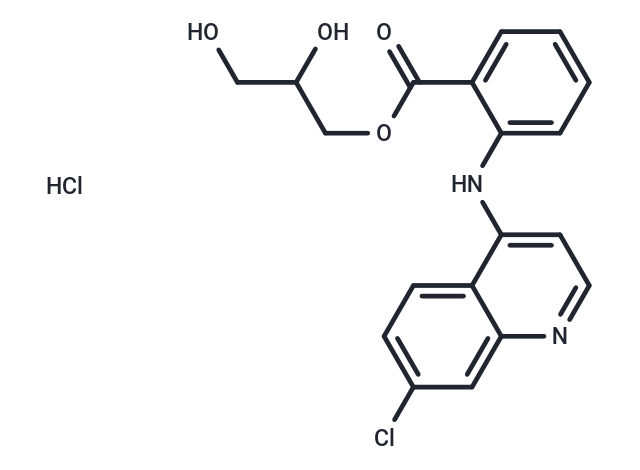Shopping Cart
- Remove All
 Your shopping cart is currently empty
Your shopping cart is currently empty

Glafenine Hydrochloride is an anti-inflammatory agent.

| Pack Size | Price | Availability | Quantity |
|---|---|---|---|
| 50 mg | $33 | In Stock | |
| 100 mg | $48 | In Stock | |
| 1 mL x 10 mM (in DMSO) | $54 | In Stock |
| Description | Glafenine Hydrochloride is an anti-inflammatory agent. |
| Targets&IC50 | ABCG2:3.2 μM |
| In vitro | Glafenine enhances the surface expression of mutant Cystic Fibrosis Transmembrane Conductance Regulator (CFTR) in baby hamster kidney (BHK) cells, achieving 40% of the expression levels seen in wild-type CFTR[2]. Additionally, Glafenine hydrochloride suppresses the proliferation and clonogenic capabilities of human aortic smooth muscle cells (haSMCs) and endothelial cells (ECs) in a dose-responsive manner, leading to a blockade at the G2/M phase of the cell cycle and a decline in the G1 phase. Moreover, it dose-dependently impairs the migratory capacity of haSMCs and decreases the level of the extracellular matrix protein tenascin[3]. |
| Cell Research | Glafenine hydrochloride is added to the culture medium of the smooth muscle cells at three concentrations (10 μM, 50 μM, 100 μM). After 4 days of treatment, cells are harvested and the absolute cell number is counted[3]. |
| Alias | Glafenin hydrochloride |
| Molecular Weight | 409.26 |
| Formula | C19H17ClN2O4·HCl |
| Cas No. | 65513-72-6 |
| Smiles | Cl.OCC(O)COC(=O)c1ccccc1Nc1ccnc2cc(Cl)ccc12 |
| Relative Density. | no data available |
| Storage | Powder: -20°C for 3 years | In solvent: -80°C for 1 year | Shipping with blue ice. | |||||||||||||||||||||||||||||||||||
| Solubility Information | DMSO: 60 mg/mL (146.61 mM), Sonication is recommended. | |||||||||||||||||||||||||||||||||||
Solution Preparation Table | ||||||||||||||||||||||||||||||||||||
DMSO
| ||||||||||||||||||||||||||||||||||||

Copyright © 2015-2025 TargetMol Chemicals Inc. All Rights Reserved.